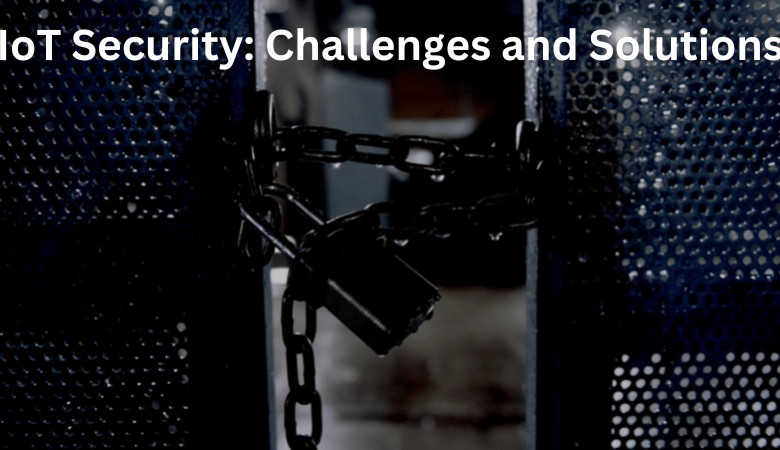IoT Security: Challenges and Solutions

IoT security has become a major concern in recent years as the number of devices connected to the internet has grown exponentially. While the benefits of the internet of things are numerous, the increased connectivity also creates new security risks. This article will explore some of the key challenges associated with securing IoT devices and networks, as well as some potential solutions.
IoT Security Challenges and Solutions
The internet of things (IoT) is a network of physical devices, vehicles, home appliances, and other items embedded with electronics, software, sensors, and connectivity which enables these objects to connect and exchange data. While the IoT brings many benefits, it also creates new security risks.
As more and more devices are connected to the internet, the number of potential entry points for hackers increases. And, as we become increasingly reliant on these devices, the consequences of a successful attack are also growing.
In this blog, we’ll explore the challenges of securing the IoT and some potential solutions.
One of the biggest challenges of securing the IoT is the sheer number of devices that are connected. It’s estimated that there are already over 8 billion devices connected to the internet, and this is expected to grow to over 20 billion by 2020.
Each of these devices is a potential entry point for hackers. And, as the IoT grows, it’s becoming increasingly difficult to secure all of these devices.
Another challenge is that many IoT devices are designed for convenience and ease of use, which means that security is often an afterthought. This is especially true for consumer devices, where users are often reluctant to sacrifice convenience for security.
Finally, the IoT is also creating new types of risks that we haven’t seen before. For example, IoT devices are often used to control physical systems, such as industrial machines or self-driving cars.
If a hacker was able to take control of one of these devices, they could cause physical damage or even loss of life.
So, how can we address these challenges?
One potential solution is to create a centralized platform that can manage and monitor all of the devices on the network. This would make it easier to identify and fix security vulnerabilities.
Another solution is to create standards for IoT security. This would make it easier for manufacturers to create secure devices and would give users more confidence in the security of the devices they’re using.
Finally, we need to raise awareness of the risks of the IoT. Too often, users are unaware of the potential risks of using IoT devices. By educating users about the risks, we can help
Introduction
IoT devices are becoming increasingly popular as they offer a convenient way to connect to the internet and perform various tasks. However, as these devices are often connected to sensitive data, they can pose a serious security risk if they are not properly secured.
There are a number of challenges that need to be addressed in order to ensure IoT security, such as the fact that these devices are often connected to unsecure networks, they have weak authentication mechanisms, and they are often not updated with the latest security patches.
There are a number of solutions that can be implemented in order to address these challenges, such as using secure protocols, implementing proper authentication measures, and keeping devices up-to-date with security patches.
IoT security is an important issue that needs to be addressed in order to ensure the safety of these devices. By implementing the proper security measures, we can help to protect our data and our devices from potential attacks.
The security challenges of IoT
The internet of things (IoT) is a system of interconnected devices, digital machines, home appliances and other objects that have the ability to collect and exchange data. The IoT has the potential to transform the way we live, work and interact with the world around us. However, as more and more devices are connected to the internet, the risk of cyberattacks and data breaches increases.
There are a number of security challenges that need to be addressed in order to make the IoT safe and secure. One of the biggest challenges is the fact that many IoT devices are not properly secured. They often have weak passwords, outdated software and are not properly configured. This makes them easy targets for hackers.
Another challenge is that the data collected by IoT devices is often sensitive. This data can include everything from our personal information and habits to the inner workings of our homes and businesses. If this data falls into the wrong hands, it could be used to exploit us or our families, or to cause serious damage to our property.
The third challenge is that the IoT is constantly evolving. New devices and applications are being added to the internet all the time, and each one of these has the potential to introduce new security vulnerabilities. As the IoT grows, so does the surface area for attack.
Fortunately, there are a number of steps that can be taken to address these challenges and make the IoT safe and secure. One of the most important is to ensure that all devices that are connected to the internet are properly secured. This means using strong passwords, keeping software up to date, and configuring devices properly.
Another important step is to encrypt the data that is collected by IoT devices. This will make it much more difficult for hackers to access and misuse this data.
Finally, it is important to keep the IoT constantly monitored. By keeping an eye on new devices and applications, we can quickly identify and address any new security vulnerabilities that may arise.
By taking these steps, we can make the IoT a safe and secure environment for everyone.
The security solutions for IoT
The internet of things (IoT) is a system of interconnected devices, vehicles, buildings and other items—embedded with electronics, software, sensors, and network connectivity that enable these objects to collect and exchange data.
The IoT promises many benefits, including improved efficiency, accuracy and safety. However, as interconnected devices become more prevalent, they also create new security risks. IoT devices are often relatively unprotected and unmonitored, making them attractive targets for attackers. In addition, because IoT devices are often connected to critical infrastructure, a successful attack on these devices could have serious consequences.
IoT security is a complex challenge, and there is no one-size-fits-all solution. However, there are a number of steps that organizations can take to secure their IoT deployments:
1. Secure the devices themselves: IoT devices should be designed with security in mind, and should be built using secure development practices. In addition, these devices should be properly configured and secured before being deployed.
2. Secure the network: The network infrastructure that supports IoT devices should be properly configured and secured. In particular, care should be taken to ensure that IoT devices are properly segmented from other parts of the network.
3. Implement security controls: A variety of security controls can be used to protect IoT deployments, including firewalls, intrusion detection and prevention systems, and data loss prevention systems.
4. Monitor and respond to threats: Organizations should monitor their IoT deployments for signs of attack or compromise, and should have a plan in place for responding to these threats.
By taking these steps, organizations can significantly improve the security of their IoT deployments.
The conclusion
The conclusion of IoT Security: Challenges and Solutions is that the IoT is here to stay and that security must be a top priority for all IoT stakeholders. The report highlights the importance of collaboration between the public and private sectors, as well as between IoT developers, manufacturers, and users, to ensure the security of the IoT.




